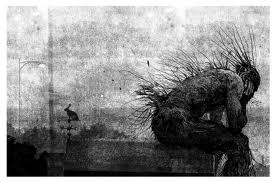
What’s it all about?:
What do you do in your teenage years when you realize what your parents taught you wasn’t enough? You must go out and find books and poetry and pop songs and bad heroes—and build yourself.
It’s 1990. Johanna Morrigan, fourteen, has shamed herself so badly on local TV that she decides that there’s no point in being Johanna anymore and reinvents herself as Dolly Wilde—fast-talking, hard-drinking gothic hero and full-time Lady Sex Adventurer. She will save her poverty-stricken Bohemian family by becoming a writer—like Jo in Little Women, or the Brontës—but without the dying-young bit.
By sixteen, she’s smoking cigarettes, getting drunk, and working for a music paper. She’s writing pornographic letters to rock stars, having all the kinds of sex with all the kinds of men, and eviscerating bands in reviews of 600 words or less.
But what happens when Johanna realizes she’s built Dolly with a fatal flaw? Is a box full of records, a wall full of posters, and a head full of paperbacks enough to build a girl after all?
Imagine The Bell Jar—written by Rizzo from Grease. How to Build a Girl is a funny, poignant, and heartbreakingly evocative story of self-discovery and invention, as only Caitlin Moran could tell it.
What did I think?:
I was lucky enough to see Caitlin Moran in London when she went on tour talking about How To Build A Girl amongst other things that I hadn’t bargained for and was thoroughly delighted with. Yep, I stood on my chair and screeched “I am a feminist,” I bought some merchandise (all proceeds going to the charity Refuge which was fantastic) and was doubled over with laughter as Caitlin read some of the er… riskier parts of the book? How To Build a Girl is the story of an ordinary girl from Wolverhampton trying to become a woman amidst all the problems that adolescence brings, with a family who are practically living on the bread line.
Johanna Morrigan struggles with her own identity, in typical teenager fashion worrying about her body shape, her music tastes, boys and the inevitable sexual experiences that follow, but at the end of everything, all she wants to do is take care of her family. Her father has been an aspiring musician for many years but has failed to make it to the big time and drinks heavily. Her mother seems to exist on a different planet after having twins, probably suffering from post-natal depression so Johanna feels quite a bit of responsibility is on her shoulders for looking after the family. However, she makes a bit of a mistake by talking to the wrong person about the disability benefits her family is on and as a result, the benefits are cut taking her family even further down the poverty line. Things seems to be looking up when Johanna wins a poetry competition and has the opportunity to appear on television. Oh dear…the social awkwardness really comes into play here when Johanna makes a hilarious gaff on the programme (that had me in stitches, by the way) and she seems doomed to stay in her house forever and never appear in public again.
The only cure for this is to re-invent herself. Johanna Morrigan becomes Dolly Wilde, who blags herself a job as a music journalist complete with lots of eyeliner. And a top hat, of course. She also decides she will become a Lady Sex Adventurer, her exploits with a man with “a uselessly large penis,” is truly hilarious and has to be read to be believed. She manages to make a fair bit of money for her large and ailing family, but at some point seems to lose a part of herself along the way. But that’s what growing up is all about, making mistakes, hopefully learning from them and becoming a stronger, independent person because of them.
Caitlin Moran has written a fantastically rude and very authentic novel about adolescence and becoming a woman. I think it’s the sort of book that young girls should be able to read (and then hide under their pillow) just for the honest way in which the author writes about all those teenage feelings. Perhaps then they would feel that they weren’t alone, and what they were experiencing was entirely normal? If it helps one teenage girl feel a bit better about themselves, I think Moran has done a great duty and I can’t help wishing that it had been around during my adolescence.
Would I recommend it?:
But of course!
Star rating (out of 5):














